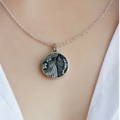Hallmarking - Why Is It Important?
WHAT DOES HALLMARKING MEAN?
Hallmarking -Why Is It So Important?
We've all heard the phrase 'hallmarked silver' but what are hallmarks and hallmarking? What do hallmarks mean and why are they so important to have? Hallmarking also has an intriguing history as you will find out below!
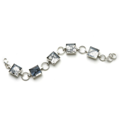
What are those marks on silver and gold?
A hallmark is a government seal that’s stamped on to precious metal objects, such as jewellery or silverware, gold, silver, platinum and, more recently, palladium.
Precious metals on their own are rarely made into functional items in their pure form, as they are too soft and bendy. They’re usually mixed with copper or other metals to create an ‘alloy’ that is more suitable to the requirements of the jeweller or silversmith.
But of course you still want as much of the valuable metal in the object as possible! The hallmark indicates the amount of precious metal in the alloy in parts per thousand. In other words, if an object is stamped with a ‘gold’ hallmark, then you know that it is indeed real gold – and not something that simply looks like gold. The same goes with silver.

What do the hallmarks mean?
Many nations carry out hallmarking. Some, such as the UK, implement a hallmark that is made up of several elements. These include:
1. a mark denoting the type of metal (eg a lion means silver)
2. the ‘Assay Office’ where the item was marked (there are only four in Britain, located in London, Birmingham, Sheffield and Edinburgh)
3. the maker’s (or sponsor's) mark
4. a date letter to represent the year of marking
In England, the year of marking commences on 19 May, because this is the feast day of Saint Dunstan – patron saint of gold - and silversmiths!
Why are hallmarks important?
Beautiful heirloom gifts made from precious metals should come with some guarantee that they are what they claim to be. In other words, they display a lasting indication of the purity of the metal used.
Testing precious metals for purity is called “assaying”. And so the places where hallmarking is done are called Assay Offices. Only one of the four authorised UK Government Assay Offices can apply a hallmark, the official stamp of quality and guaranteed standards. This also ensures that the trade of legitimate jewellers is protected from unlawful competitors who might try to pass off lower quality jewellery as the “real deal”.
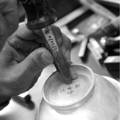
When did hallmarking start?
The use of hallmarks, at first on silver, has a long history dating back to the 4th century AD. There’s evidence of silver bars with inspection punch marks under the authority of Emperor Augustinian around AD 350. This is probably the oldest known form of consumer protection! A series or system of five marks has been found on Byzantine silver dating from this period, though historians are still debating precisely what they mean.
How old is hallmarking in the UK?
Hallmarking in England dates back to the 14th century when Edward I passed a law requiring any item made of silver to be at least of equal quality as that of the coin of the realm (silver currency). At the time coins were made of the pukka stuff – and folks could shave a little off the edges of the silver pieces and melt the shavings down for profit!
To check on the quality of goods, the four wardens of the Goldsmiths’ Company were tasked with visiting workshops in the City of London to test silver articles for sale. If they were found to be below standard they were originally forfeit to the king. But if they passed, each item received the King's mark of authentication – which just happened to be a leopard's head.
By 1478, there were hundreds of workshops making silver articles in the City of London. The wardens couldn’t visit them all, so the merchants were ordered to bring their items to Goldsmiths’ Hall for testing and marking. A permanent Assay Office was established in the building, and this is the origin of the term ‘hallmark’ – struck with the King's mark at Goldsmiths’ Hall.

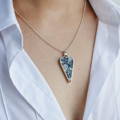
Is hallmarked jewellery more valuable?
Hallmarked jewellery is not necessarily more valuable – it all depends on the design, any precious stones used, the rarity, and of course the brand!
However, ALL precious metals in jewellery that are of a declared purity (eg ‘925’ = 92.5% pure silver in Sterling Silver) must by law have the relevant hallmarks. So it’s best to have a quick look at the item or the spec before you buy. (The only exceptions are tiny pieces – eg less than 1 gramme for gold – that would be damaged or defaced by the stamp.)

Should real silver jewellery always be hallmarked?
Unless it’s a very small item (less than 7.8g), the real silver jewellery should be hallmarked. The mark gives the buyer assurance and protection against unscrupulous sellers. (And gives the recipient of any silver gift some reassurance too!)
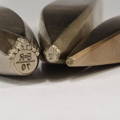
Is hallmarked jewellery a special gift?
If you want a sentimental gift that shows careful consideration and a concern for quality, a jewellery piece that includes hallmarked precious metal is a very special choice.
You’ve heard of ‘heirloom’ pieces? That’s when jewellery has been in a family for generations, being passed down over the years. Heirloom pieces therefore need provenance – and hallmarks give them just that.
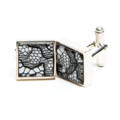
Does Lily Gardner Silver have a Hallmark?
As the designer and creator of silver jewellery, Lily Gardner has, since 2015, had her own official Maker’s Mark on the pieces. This gives the items even more provenance that will retain value over the years to come. Look for the neat ‘LG’ mark on, for example, the backs or bails (links) of our lace-in-silver jewellery collection.
